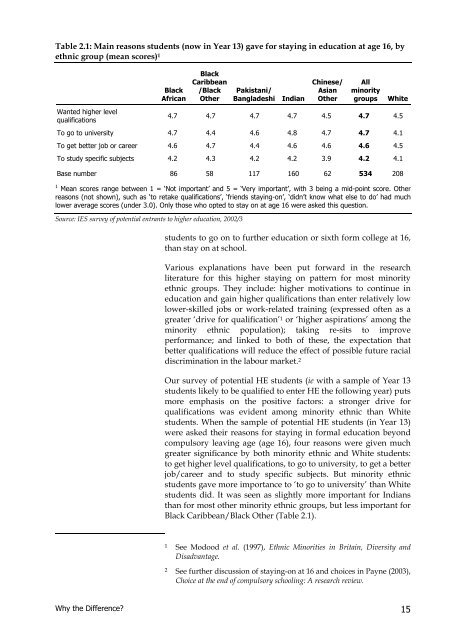A Closer Look at Higher Education Minority Ethnic Students and ...
A Closer Look at Higher Education Minority Ethnic Students and ...
A Closer Look at Higher Education Minority Ethnic Students and ...
Create successful ePaper yourself
Turn your PDF publications into a flip-book with our unique Google optimized e-Paper software.
Table 2.1: Main reasons students (now in Year 13) gave for staying in educ<strong>at</strong>ion <strong>at</strong> age 16, byethnic group (mean scores) 1Wanted higher levelqualific<strong>at</strong>ionsBlackAfricanBlackCaribbean/BlackOtherPakistani/BangladeshiIndianChinese/AsianOtherAllminoritygroupsWhite4.7 4.7 4.7 4.7 4.5 4.7 4.5To go to university 4.7 4.4 4.6 4.8 4.7 4.7 4.1To get better job or career 4.6 4.7 4.4 4.6 4.6 4.6 4.5To study specific subjects 4.2 4.3 4.2 4.2 3.9 4.2 4.1Base number 86 58 117 160 62 534 2081 Mean scores range between 1 = ‘Not important’ <strong>and</strong> 5 = ‘Very important’, with 3 being a mid-point score. Otherreasons (not shown), such as ‘to retake qualific<strong>at</strong>ions’, ‘friends staying-on’, ‘didn’t know wh<strong>at</strong> else to do’ had muchlower average scores (under 3.0). Only those who opted to stay on <strong>at</strong> age 16 were asked this question.Source: IES survey of potential entrants to higher educ<strong>at</strong>ion, 2002/3students to go on to further educ<strong>at</strong>ion or sixth form college <strong>at</strong> 16,than stay on <strong>at</strong> school.Various explan<strong>at</strong>ions have been put forward in the researchliter<strong>at</strong>ure for this higher staying on p<strong>at</strong>tern for most minorityethnic groups. They include: higher motiv<strong>at</strong>ions to continue ineduc<strong>at</strong>ion <strong>and</strong> gain higher qualific<strong>at</strong>ions than enter rel<strong>at</strong>ively lowlower-skilled jobs or work-rel<strong>at</strong>ed training (expressed often as agre<strong>at</strong>er ‘drive for qualific<strong>at</strong>ion’ 1 or ‘higher aspir<strong>at</strong>ions’ among theminority ethnic popul<strong>at</strong>ion); taking re-sits to improveperformance; <strong>and</strong> linked to both of these, the expect<strong>at</strong>ion th<strong>at</strong>better qualific<strong>at</strong>ions will reduce the effect of possible future racialdiscrimin<strong>at</strong>ion in the labour market. 2Our survey of potential HE students (ie with a sample of Year 13students likely to be qualified to enter HE the following year) putsmore emphasis on the positive factors: a stronger drive forqualific<strong>at</strong>ions was evident among minority ethnic than Whitestudents. When the sample of potential HE students (in Year 13)were asked their reasons for staying in formal educ<strong>at</strong>ion beyondcompulsory leaving age (age 16), four reasons were given muchgre<strong>at</strong>er significance by both minority ethnic <strong>and</strong> White students:to get higher level qualific<strong>at</strong>ions, to go to university, to get a betterjob/career <strong>and</strong> to study specific subjects. But minority ethnicstudents gave more importance to ‘to go to university’ than Whitestudents did. It was seen as slightly more important for Indiansthan for most other minority ethnic groups, but less important forBlack Caribbean/Black Other (Table 2.1).1 See Modood et al. (1997), <strong>Ethnic</strong> Minorities in Britain, Diversity <strong>and</strong>Disadvantage.2 See further discussion of staying-on <strong>at</strong> 16 <strong>and</strong> choices in Payne (2003),Choice <strong>at</strong> the end of compulsory schooling: A research review.Why the Difference? 15
















